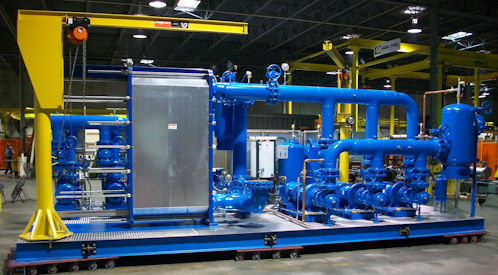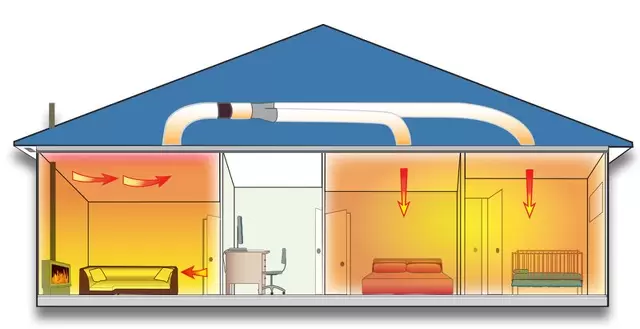What’s Next for DVS Heat Transfer Systems in the Era of Smart Thermal Infrastructure
A Comprehensive Overview to Selecting the Right Heat Transfer Solutions for Your Needs
Picking the proper Heat transfer system is crucial for functional efficiency. Numerous systems deal with various needs, affected by elements such as temperature level array and liquid type. Recognizing the concepts behind Heat transfer, such as conduction, convection, and radiation, is important. Additionally, evaluating power sources and maintenance practices can impact long-lasting performance. A closer assessment of these factors to consider reveals how to tailor a system to certain needs. What should one prioritize in this complex decision-making process?
Understanding Heat Transfer: Key Concepts and Concepts
Although Heat transfer might appear like a straightforward principle, it incorporates a series of concepts that are fundamental for effective system design. Understanding these principles is vital for designers and engineers who intend to maximize thermal efficiency in numerous applications. Transmission, for example, entails the transfer of Heat with strong materials, while convection describes the movement of Heat within fluids. Radiation, another crucial principle, describes how Heat can be transferred via electromagnetic waves. Each of these devices plays a vital role in establishing just how energy relocates within a system. By completely grasping these ideas, professionals can make educated decisions, guaranteeing that Heat transfer systems run efficiently and meet the details needs of their applications
Kinds of Heat Transfer Systems: An Introduction
Comprehending the principles of Heat transfer prepares for checking out the various kinds of Heat transfer systems offered. Heat transfer systems can be categorized mostly right into 3 types: radiation, convection, and conduction. Conduction includes Heat transfer via strong materials, relying upon direct call between bits. Convection, on the various other hand, takes place in liquids (gases and liquids) where the activity of the liquid itself facilitates Heat transfer. Radiation entails the transfer of Heat with electromagnetic waves and does not require a medium, permitting it to happen in a vacuum cleaner. Each type of system has distinct attributes and applications, making it crucial for individuals and organizations to carefully examine their certain needs when selecting the most suitable Heat transfer option.
Applications of Heat Transfer Solutions in Numerous Industries
Heat transfer systems play a crucial duty across numerous sectors, influencing performance and product quality. In industrial manufacturing processes, they assist in exact temperature control, while in food and drink handling, they assure security and conservation. In addition, HVAC and climate control systems count heavily on reliable Heat transfer to maintain comfortable environments.
Industrial Production Processes

Many commercial production procedures count heavily on efficient Heat transfer systems to take full advantage of performance and improve product top quality. In industries such as metalworking, Heat exchangers play an important duty in maintaining optimal temperature levels throughout welding, spreading, and forging. These systems ensure consistent Heat distribution, which is essential for accomplishing desired product properties. In the chemical production sector, Heat transfer systems facilitate specific temperature level control throughout responses, affecting return and security. In textile production, reliable Heat management is essential for coloring and ending up processes, affecting shade consistency and material high quality. By picking suitable Heat transfer modern technologies, manufacturers can enhance power performance and decrease functional prices, ultimately causing a more sustainable and affordable production environment.
Food and Drink Processing
Reliable Heat transfer systems are just as important in the food and beverage handling industry, where keeping optimal temperature levels is crucial for food safety and top quality. These systems play an important function in procedures such as pasteurization, sterilization, and cooking, making certain that products are safe for consumption and keep their nutritional value. Heat exchangers, as an example, successfully move Heat between fluids, optimizing power usage while reducing temperature changes. Furthermore, refrigeration systems are essential for extending and preserving perishable items rack life. The selection of Heat transfer modern technology directly affects operational effectiveness and item stability, making it critical for food and beverage makers to choose the ideal systems tailored to their specific handling demands. This mindful selection eventually adds to customer satisfaction and food safety and security.

Cooling And Heating and Environment Control
While many markets count on Heat transfer systems for performance, COOLING AND HEATING (Home Heating, Ventilation, and Air Conditioning) plays a vital function in preserving indoor environment control throughout various settings. These systems make use of Heat transfer principles to manage temperature level, air, and moisture top quality, ensuring convenience and safety in domestic, commercial, and industrial atmospheres. Properly developed heating and cooling systems improve energy effectiveness, lower operational costs, and reduce environmental effect. In business buildings, for circumstances, efficient environment control contributes to worker efficiency and client satisfaction. In industrial applications, heating and cooling systems aid maintain excellent conditions for equipment procedure and item preservation. Selecting the appropriate Heat transfer system is important for conference details environment control requirements and achieving total system efficiency.
Evaluating Energy Sources for Heat Transfer Systems
In a knockout post reviewing energy resources for Heat transfer systems, a comparison of sustainable power choices and nonrenewable fuel source factors to consider is important. Renewable resources, such as solar and wind, offer lasting alternatives that can reduce ecological influence. Alternatively, nonrenewable fuel sources stay common because of their well established framework and power density, motivating a mindful analysis of both alternatives.
Renewable Resource Options

Fossil Fuel Considerations
Reviewing nonrenewable fuel source factors to consider is important for the effectiveness and sustainability of Heat transfer systems. Fossil fuels, such as all-natural gas, oil, and coal, are traditional energy sources that provide considerable Heat output, making them preferred choices for industrial and household applications. However, their environmental impact, including greenhouse gas emissions and resource depletion, increases worries. When choosing a warmth transfer system, it is crucial to assess the availability, price, and regulative aspects associated with these fuels. Additionally, the effectiveness of nonrenewable fuel source systems should be taken into consideration, as higher effectiveness can minimize some environmental disadvantages. Eventually, a well balanced technique considering efficiency and sustainability can guide decision-makers toward the most proper Heat transfer option for their particular needs.
Variables to Consider When Choosing a Warmth Transfer System
Choosing an appropriate Heat transfer system requires careful factor to consider of various variables that can significantly influence performance and performance. One important variable is the operating temperature variety, which dictates the materials and design appropriate for the application. In addition, the kind of fluid utilized in the system-- whether gas or fluid-- impacts Heat transfer performance and compatibility. The system's dimension and capacity need to line up with the details needs of the operation to prevent inadequacies. Energy resource accessibility is also vital, influencing operating expenses and sustainability. The installment environment, including room constraints and access for upkeep, plays a substantial duty in system selection. Regulative compliance and security criteria must be taken into consideration to ensure the system fulfills all lawful needs.
Maintenance and Effectiveness Optimization for Heat Transfer Solutions
Keeping Heat transfer systems is essential for making sure optimal effectiveness and durability. Normal maintenance tasks, such as cleansing Heat exchangers and evaluating insulation, aid protect against effectiveness losses as a result of fouling and thermal connecting. In addition, keeping track of system specifications, including pressure and temperature, permits for very early detection of anomalies, reducing downtime and pricey repair services. Applying a precautionary maintenance schedule can optimize performance and prolong the life-span of elements. Updating to sophisticated control systems can improve functional efficiency by changing to varying problems and loads. By focusing on upkeep and performance optimization, drivers can accomplish decreased power intake, lower functional prices, and enhanced total system integrity, ultimately leading to better resource application and an extra sustainable operation.
Future Fads in Heat Transfer Technologies
As sectors progressively prioritize sustainability and energy performance, future fads in Heat transfer modern technologies are readied to undertake significant changes. go Innovations such as sophisticated products, including carbon nanotubes and nanofluids, guarantee enhanced thermal conductivity and performance. In addition, the integration of renewable resource resources right into Heat transfer systems is gaining energy, promoting green solutions. Smart innovations, including IoT sensing units, are expected to reinvent surveillance and control, enabling real-time data evaluation for optimized efficiency. Furthermore, the growth of small and modular systems will certainly assist in much easier setup and upkeep, satisfying varied applications. These developments show a change in the direction of even more sustainable, effective, and adaptable Heat transfer solutions, straightening with worldwide energy goals and environmental requirements.
Frequently Asked Concerns
What Are the Environmental Impacts of Heat Transfer Equipments?
The ecological influences of Heat transfer systems can include greenhouse gas discharges, energy consumption, and prospective thermal air pollution. Furthermore, incorrect disposal of products and inefficiencies can add to resource exhaustion and ecological community disruption.
Exactly how Do I Calculate the Cost-Effectiveness of a Warm Transfer System?
To determine the cost-effectiveness of a warm transfer system, one have to assess first costs, operational expenditures, upkeep demands, and power efficiency, comparing these factors against the anticipated lifespan and efficiency of the system.
Can Heat Transfer Solution Be Made Use Of in Residential Settings?
Heat transfer systems can undoubtedly be used in property setups. They provide efficient heating and cooling solutions, making homes extra comfy while potentially decreasing power expenses. Their adaptability permits numerous applications in domestic settings.
What Safety And Security Laws Relate To Heat Transfer Solutions?
Safety policies for Heat transfer systems typically include standards on operation, upkeep, and installation. Conformity with regional building codes, maker requirements, and sector requirements is necessary to guarantee safe and efficient system performance in various applications.
Just How Do Various Materials Affect Heat Transfer Performance?

Conduction, for circumstances, includes the transfer of Heat through solid products, while convection refers to the motion of Heat within fluids. Recognizing the principles of Heat transfer lays the foundation for discovering the different types of Heat transfer systems readily available. Heat exchangers, for circumstances, efficiently move Heat in between liquids, enhancing energy use while decreasing temperature changes. In assessing power resources for Heat transfer systems, a contrast of renewable energy choices and fossil gas considerations is necessary. Metals, such as copper and light weight aluminum, conduct Heat properly, whereas insulators like rubber and glass reduce down Heat circulation.